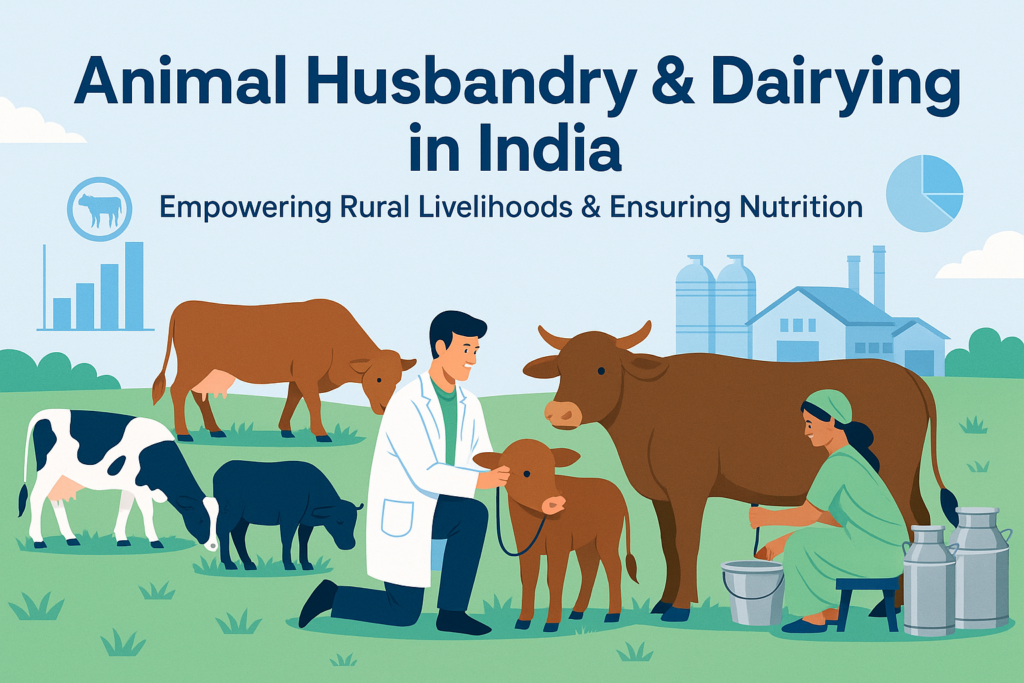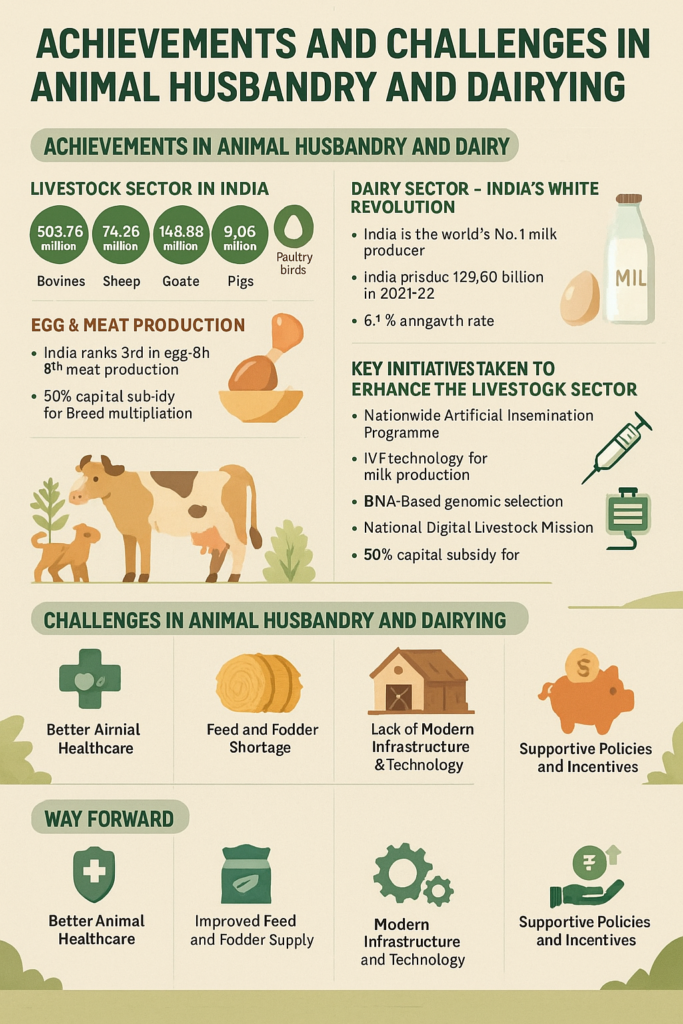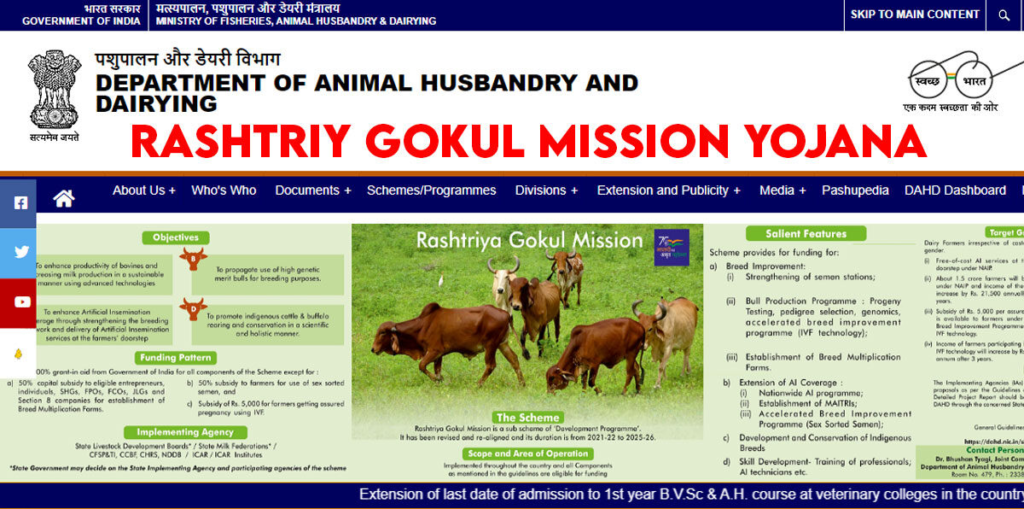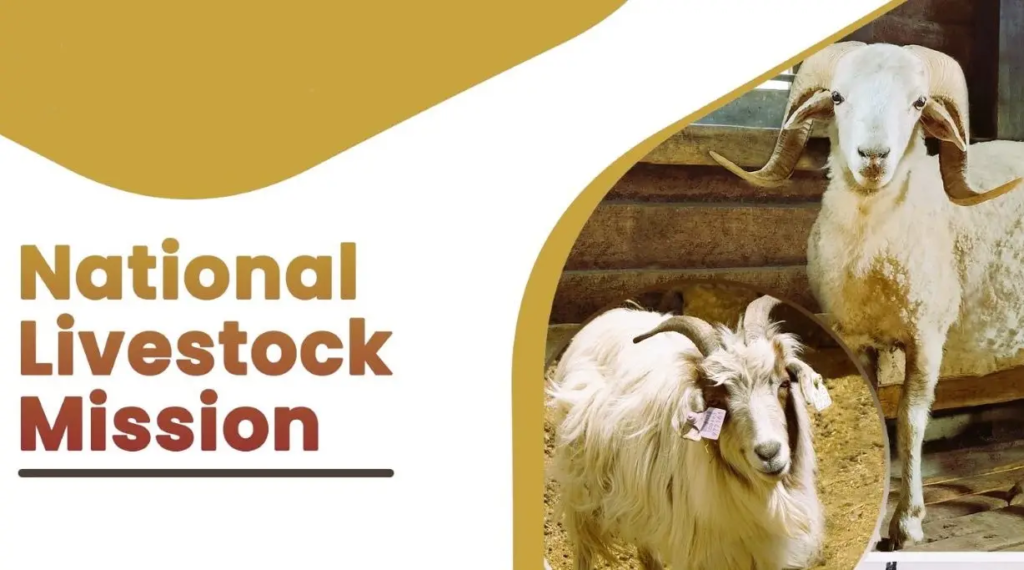
Introduction
The Department of Animal Husbandry & Dairying (DAHD) operates under the Ministry of Fisheries, Animal Husbandry & Dairying, established on May 31, 2019 — carving out animal husbandry and dairying from the broader agriculture ministry to offer focused governance and support.
Achievements in Animal Husbandry and Dairy
Livestock Sector in India
The livestock sector plays a vital role in India’s rural economy. From 2014-15 to 2020-21, it grew at a strong annual rate of 7.93%, showing how important it has become for farmers and the overall agricultural landscape.
- In fact, the livestock sector’s share in agriculture has increased significantly—from about 24% in 2014-15 to nearly 31% in 2020-21.
- India has one of the largest livestock populations in the world, including:
- 303.76 million bovines (cows, buffaloes)
- 74.26 million sheep
- 148.88 million goats
- 9.06 million pigs
- A whopping 851.81 million poultry birds
Dairy Sector – India’s White Revolution
Dairy is the largest agricultural product in India, making up about 5% of the national economy. More than 8 crore farmers are directly involved in dairy farming.
- India is the world’s No. 1 milk producer, contributing 23% of the global milk supply.
- Milk production in India has grown by over 51% in just 8 years, reaching 221.06 million tonnes in 2021-22.
- The annual growth rate of milk production is 6.1%, far ahead of the global average of 1.2%.
- On average, every Indian now gets about 444 grams of milk per day, which is more than the global average of 394 grams.
Egg & Meat Production
India is also a major producer of eggs and meat:
- It ranks 3rd in the world for egg production and 8th for meat production.
- Egg production rose from 78.48 billion in 2014-15 to 129.60 billion in 2021-22, growing steadily at 7.4% per year.
- Meat production increased from 6.69 million tonnes to 9.29 million tonnes during the same period.
In Simple Terms
India’s livestock and dairy sectors are not only feeding the nation but also driving rural livelihoods, boosting the economy, and helping the country become a global leader in milk, eggs, and meat production.

Key Initiatives Taken to Enhance the Livestock Sector

- The Government of India has launched several impactful initiatives to strengthen the livestock and dairy sectors, especially under the Rashtriya Gokul Mission. One of the major achievements is the Nationwide Artificial Insemination Programme, which has covered over 5.71 crore animals, directly benefiting around 3.74 crore farmers. Artificial insemination, a scientific technique to impregnate female animals, has significantly improved breeding outcomes. To further boost milk production, IVF technology and sex-sorted semen are being promoted, enabling farmers to produce mostly female calves with over 90% accuracy—this ensures a faster growth rate in milk yield.
- DNA-based genomic selection is also being used to identify the best indigenous breeds, while animal identification and traceability has reached over 53.5 crore animals using unique ID tags. Programs like progeny testing and pedigree selection help improve the quality of specific cattle and buffalo breeds.

- To support the sector digitally, the National Digital Livestock Mission is being developed, aiming to enhance productivity, control diseases, and ensure quality produce for domestic and export markets. Financial support has also been introduced. Breed multiplication farms are being set up with 50% capital subsidy (up to ₹2 crore) to private players. During difficult times like natural calamities, soft working capital loans are provided to dairy cooperatives and Farmer Producer Organizations (FPOs).
- Infrastructure development is also a priority through schemes like the Dairy Processing & Infrastructure Development Fund (DIDF), which supports milk processing and value addition. Likewise, the National Livestock Mission offers direct subsidies to individuals and FPOs to start poultry, piggery, and other livestock-based farms. Under the Animal Husbandry Infrastructure Development Fund, investments in meat and dairy processing units, feed plants, and modern breeding are being encouraged.
- Health is another focus. Under the Livestock Health and Disease Control Programme, around 25 crore animals have been tagged, over 24 crore vaccinated against Foot and Mouth Disease (FMD), and more than 2 crore vaccinated against Brucellosis. Additionally, Mobile Veterinary Units (MVUs) are operational in many states to provide door-step care.

- For planning and policy, data from the Integrated Sample Survey and 20th Livestock Census (2019) help estimate livestock product output and population details across regions and species. Lastly, to provide financial help, over 27.65 lakh Kisan Credit Cards (KCCs) have been sanctioned for dairy farmers involved with milk cooperatives and producer companies—helping them access easy credit and grow their business.
Challenges in Animal Husbandry and Dairying
The livestock and dairy sector in India faces several practical challenges that impact its growth and productivity:
- Animal Health & Disease Control:
- Farmers often struggle with managing diseases among their animals. Common infections like Foot and Mouth Disease (FMD) and Brucellosis not only affect animal health but also reduce milk and meat production. Many areas still lack timely veterinary care and vaccination coverage.
- Feed and Fodder Shortage:
- Good quality feed and green fodder are essential for healthy and productive livestock. However, most farmers face a shortage of affordable and nutritious animal feed, which directly impacts the health of their animals and their output.
- Lack of Modern Infrastructure & Technology:
- Many farmers are still dependent on traditional methods of animal rearing. Access to modern equipment for milking, breeding, storage, and processing is very limited, especially in rural areas. This limits efficiency and reduces the overall quality of products.
- Shortage of Skilled Personnel & Veterinary Services:
- There are not enough trained veterinarians and animal health workers, particularly in remote areas. Without expert guidance, farmers find it difficult to handle disease outbreaks, breed improvement, or advanced care practices.
- Financial Constraints & Limited Credit:
- Small and marginal farmers often do not have enough capital to invest in better animals, infrastructure, or feed. Access to bank loans or schemes like Kisan Credit Cards is still limited for many, making it hard for them to expand or modernize their operations.
- Marketing & Distribution Challenges:
- Even when farmers produce good quality milk, eggs, or meat, they face problems in reaching markets. Lack of cold storage, poor transport, middlemen exploitation, and fluctuating prices make it difficult for them to earn a fair income.
These issues highlight the need for stronger support systems, awareness programs, better infrastructure, and easy access to credit and veterinary services to truly unlock the potential of India’s livestock sector.
Way Forward
To improve the livestock and dairy sector in India, several practical steps can be taken to tackle current challenges and boost productivity:
- Better Animal Healthcare:
- We need to improve veterinary services by setting up more animal clinics and mobile units, especially in rural areas. Regular vaccination drives and health check-ups should be promoted to keep animals disease-free. Early detection systems for diseases should be strengthened so that issues can be treated before they spread.
- Improved Feed and Fodder Supply:
- Good nutrition is essential for healthy livestock. Farmers should be encouraged to grow high-quality fodder crops. Modern methods like hydroponics—growing plants without soil using nutrient-rich water—and silage production—fermenting green crops for year-round animal feed—can ensure a steady and nutritious feed supply. Setting up local feed processing units will also help.
- Modern Infrastructure and Technology:
- Livestock farms, milk collection centers, and veterinary clinics should be upgraded with modern tools and equipment. Advanced technology like artificial insemination, automated milking machines, and disease-monitoring apps should be made accessible to farmers. At the same time, investment in research and innovation will help improve breeding, nutrition, and animal health practices.
- Supportive Policies and Incentives:
- The government should create policies that support animal husbandry and dairying at all levels. Providing subsidies, soft loans, and tax benefits to farmers and entrepreneurs will attract more investment in the sector and encourage the adoption of better practices.
In short, a combination of better healthcare, quality feed, modern facilities, and supportive policies can transform India’s livestock and dairy industry into a more efficient and sustainable sector.















